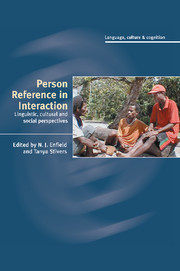Book contents
- Frontmatter
- Contents
- List of contributors
- Preface
- Acknowledgements
- 1 Person reference in interaction
- Part I Person reference as a system
- Part II The person reference system in operation
- 6 Conveying who you are: the presentation of self, strictly speaking
- 7 Person reference in Yucatec Maya conversation
- 8 Principles of person reference in Tzeltal conversation
- 9 The interactional meanings of quasi-pronouns in Korean conversation
- 10 Person reference in Tzotzil gossip: referring dupliciter
- Part III The person reference as a system in trouble
- References
- Index
7 - Person reference in Yucatec Maya conversation
Published online by Cambridge University Press: 22 September 2009
- Frontmatter
- Contents
- List of contributors
- Preface
- Acknowledgements
- 1 Person reference in interaction
- Part I Person reference as a system
- Part II The person reference system in operation
- 6 Conveying who you are: the presentation of self, strictly speaking
- 7 Person reference in Yucatec Maya conversation
- 8 Principles of person reference in Tzeltal conversation
- 9 The interactional meanings of quasi-pronouns in Korean conversation
- 10 Person reference in Tzotzil gossip: referring dupliciter
- Part III The person reference as a system in trouble
- References
- Index
Summary
Construing persons
When speakers of any language make reference to objects, persons or events, they do so in terms of the social and linguistic categories of their communities. This is true both when they use standard semantic terms such as definite descriptions and when they use names or indexicals, with or without gestures. Moreover, in referring to a person as ‘Manuel’, ‘my friend from Yucatan’, ‘the guy with the white hat’, ‘your husband’, and so forth, the speaker unavoidably presupposes and activates background knowledge. This background knowledge is part of the perspective under which the speaker individuates the referent.
This practice of individuating under a perspective is what I have called construal (Croft and Cruse 2004; Hanks 2005; cf. Langacker 1987). In formulating a person with a descriptor, a name or a participant deictic, the speaker construes the person in a certain way. Indexical construal is a linguistically mediated, cognitively rich act and it must be studied at the token level. Construal unavoidably engages both the local context of utterance and the background of social common sense. It requires what Sachiko Ide (1985, 2005) has called ‘discernment’ (wakimae). The speaker must discern the appropriate perspective under which to construe the referent according to social norms that vary from language community to language community.
Research on informal conversation in US English suggests that in referring to persons, the simplest and most unmarked construal is the (first) name (Schegloff 1996a).
- Type
- Chapter
- Information
- Person Reference in InteractionLinguistic, Cultural and Social Perspectives, pp. 149 - 171Publisher: Cambridge University PressPrint publication year: 2007
- 7
- Cited by



